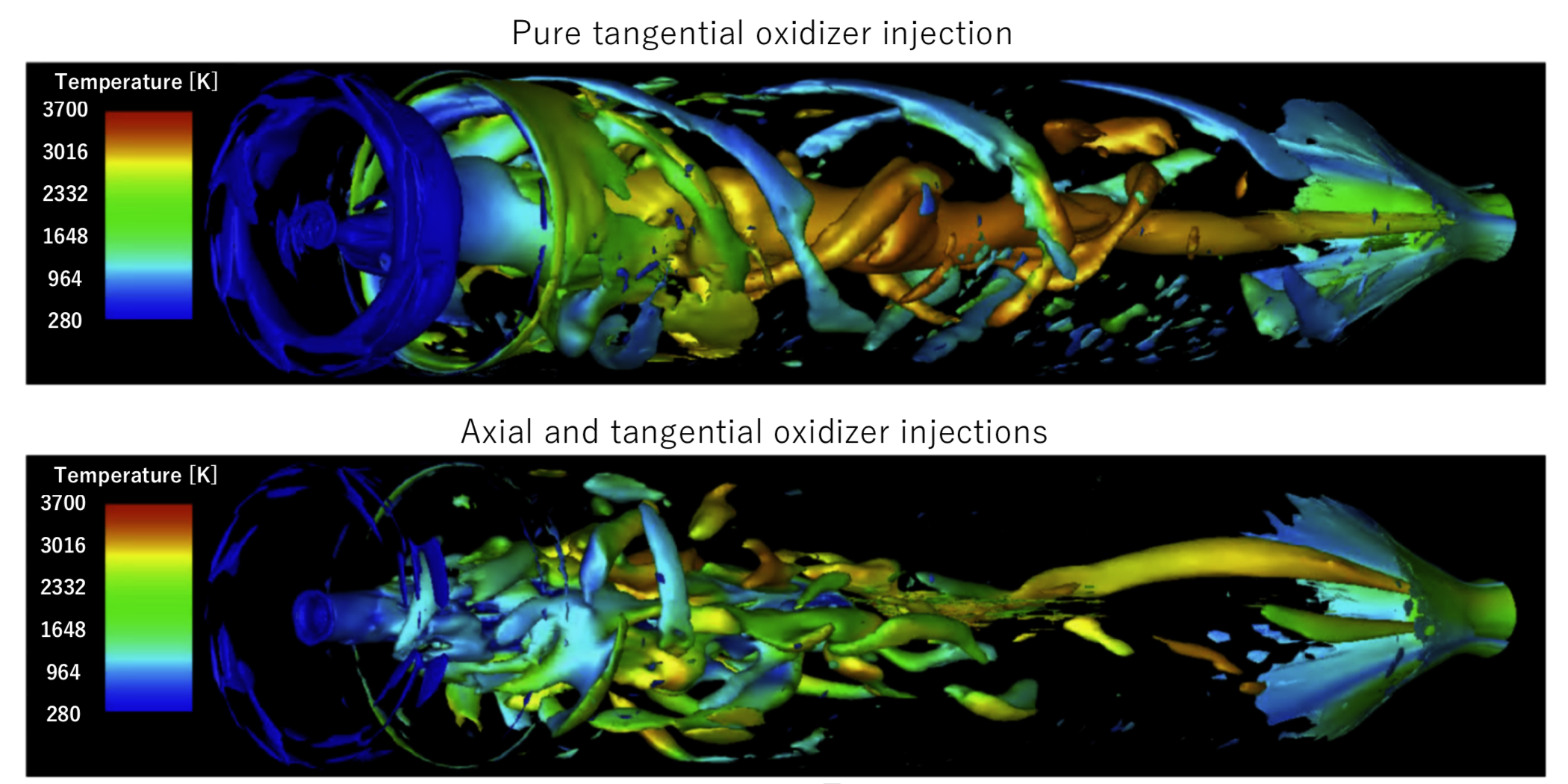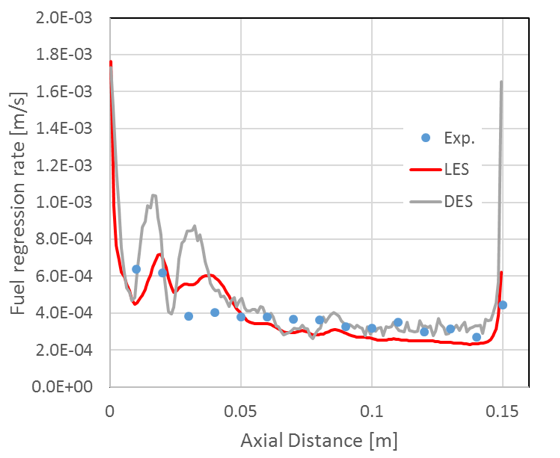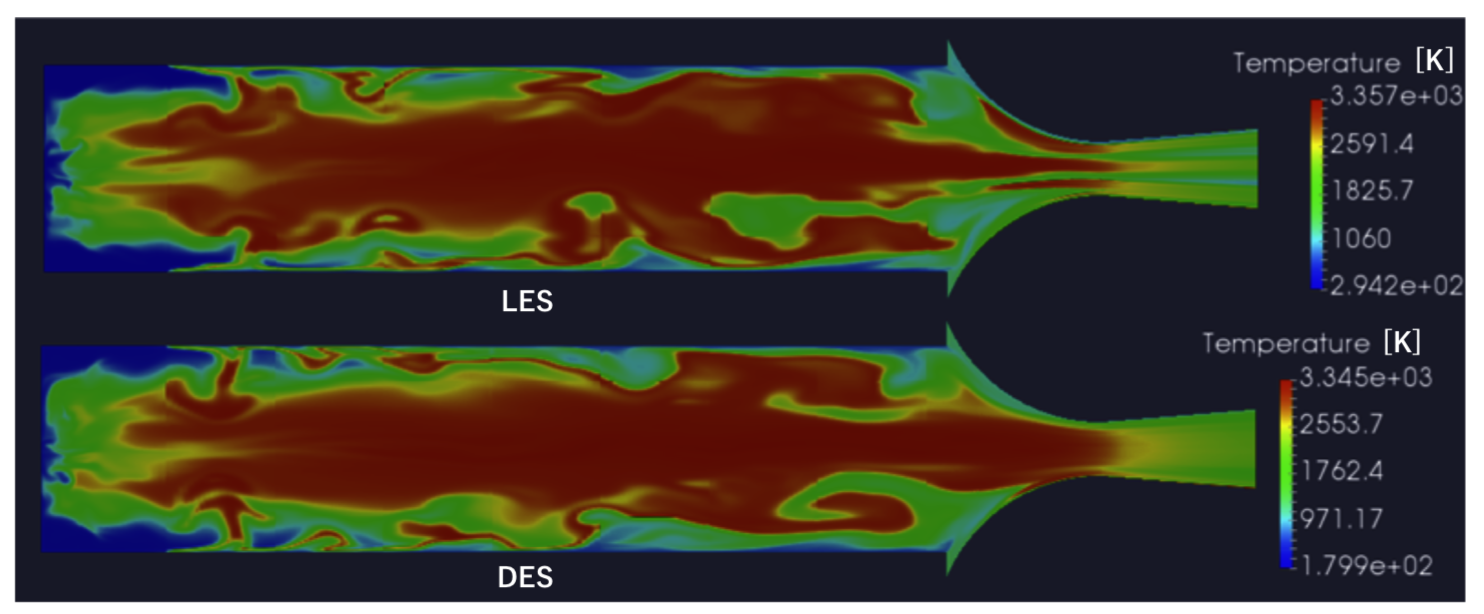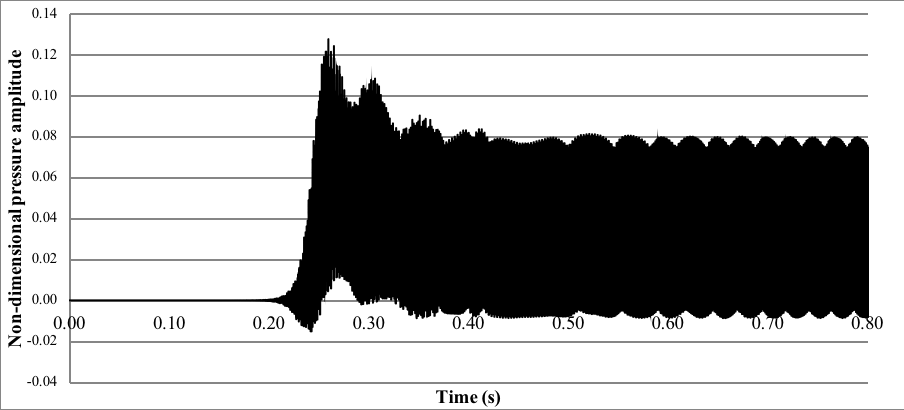Research on Space Propulsion Flow Dynamics
JAXA Supercomputer System Annual Report April 2017-March 2018
Report Number: R17EU0802
Subject Category: Space and Astronautical Science
- Responsible Representative: Eiichi Sato, Department of Space Flight Systems, Institute of Space and Astronautical Science
- Contact Information: Tomoki Matsuno matsuno.tomoki@ac.jaxa.jp
- Members: Toru Shimada, Mikiro Motoe, Tomoki Matsuno, Goutham Karthikeyan, Akiyo Takahashi
Abstract
It is natural and logical to require safe and economic space transportation for the realization of sustainably growing future space economy. However, the current space transportation system cannot be as safe as the current aircraft because the current rocket has essential explosive nature of the propellant.
In order to realize non-explosive safe rocket, we suggest A-SOFT hybrid rocket and research on computer simulation of swirling turbulent combustion field and combustion oscillation in hybrid rocket engine for realization of this type of rocket.
Safety evaluation of hybrid rocket with numerical analysis is also conducted.
Reference URL
N/A
Reasons for using JSS2
It is impossible to conduct practical numerical analysis for turbulent combustion phenomena with general computer from the perspective of computing speed and memory capacity. Therefore high speed and large scale analysis with super computer is necessary for development of hybrid rocket.
Achievements of the Year
In order to understand the influence of the ratio of axial-to-tangential oxidizer mass flow rate on the internal combustion flow field of A-SOFT, unsteady combustion turbulent flow analysis is conducted on 2 cases of A-SOFT hybrid rocket. Their difference is only axial-to-tangential oxidizer mass flow rate. POD analysis is also applied to the simulation results. Fig. 1 shows the comparison of instantaneous eddy structure. Through this simulation, the difference of engine performance and internal combustion field are observed.
In order to establish scheme of unsteady combustion simulation for hybrid rocket, Detached-eddy simulation (DES) have been conducted to the rocket and its results are compared with results of Large-eddy Simulation (LES). Fig.2 shows numerical estimations and an experimental result of axial distribution of fuel regression rate of swirling-oxidizer-flow-type hybrid rocket (numerical estimations are instantaneous value). Fig.3 shows contours of temperature that are obtained from LES and DES. These result show that both methods can conduct reasonable simulation for such kind of hybrid rocket.
Numerical analysis on the combustion stability characteristics of hybrid rocket (HR) motors was conducted in order to study the HR intrinsic low-frequency instability. Through the unsteady computational fluid dynamics simulation, we were able to model the phenomenon (Fig. 4) and parametrically analyze it.
We studied about safety of space transportation from the view of resilience engineering which is new method of system safety engineering, and we showed that adoption of boundary layer combustion type hybrid rocket has the possibility of contributing safely. To show the possibility quantitatively, we constructed a mathematical model including CFD program to evaluate damage of blast of hybrid rocket propellant.
Publications
■ Non Peer-reviewd papers
1)Takahashi, A., Shimada, T., “Essentially Non-explosive propulsion Paving a Way for Fail-Safe Space Transportation,” TRANSACTIONS OF THE JAPAN SOCIETY FOR AERONAUTICAL AND SPACE SCIENCES, AEROSPACE TECHNOLOGY JAPAN, ISTS Special Issue, Vol.16(2018), No.1, pp.1-8.
■ Presentations
1)M. Motoe, T. Matsuno and T. Shimada, “Numerical Analysis of Combustion Field in Hybrid Rocket Motor with Swirling and Axial Oxidizer Injection”, 7th EUCASS, July 3-6, 2017, Milan, Italy.
2)T. Shimada, T. Matsuno, K. Obata, G. Karthkeyan, and M. Motoe. “Evaluation of Non-steady Combustion Characteristics of Tangential-Axial Injection Hybrid Rocket by Large Eddy Simulation.” Fourteenth ICFD, November 1-3, 2017, Sendai, Japan.
3)T. Matsuno, M. Motoe, K. Obata, N. Kimura, K. Kitagawa and T. Shimada, “Swirling Combustion Flow Field Evaluation of Tangential-Axial Injection Hybrid Rocket by Large Eddy Simulation”, 9th AJCPP, March 14-17, 2017, Xiamen, China.
4)Mikiro Motoe, “Delayed Detached Eddy Simulation of Combustive Flows in a Swirling-Oxidizer-Flow-Type Hybrid Rocket”, 31st ISTS, June 3-9, 2017, Matsuyama, Japan.
5)Karthikeyan, Goutham, and Toru Shimada. “Parametric Analysis of Combustion Instability in Axial-Injected Hybrid Rocket Motors using Computational Fluid Dynamics”, 53rd AIAA/SAE/ASEE Joint Propulsion Conference, July 10-12, 2017, Atlanta, USA.
6)Karthikeyan, Goutham, and Toru Shimada. “Validation of numerical prediction of hybrid rocket combustion instability”, Fourteenth ICFD, November 1-3, 2017, Sendai, Japan.
7)Takahashi, A., Shiamda, T., “Resilience Engineering of Space Transportation,” Mechanical Engineering Congress, 2017 Japan, 9/5, Saitama (in Japanese).
8)Takahashi, A., Shimada, T., “Essentially Non-explosive propulsion Paving a Way for Fail-Safe Space Transportation,” 31st International Symposium on Space Technology and Science, Matsuyama, 2017.6.3-6.9.
9)Takahashi, A., Shimada, T., “Evaluation of Energy for Detonation Occurrence of Space Propulsion System”, Asia Pacific Symposium on Safety 2017, Fukuoka, 2017/12/1.
Usage of JSS2
Computational Information
- Process Parallelization Methods: MPI
- Thread Parallelization Methods: N/A
- Number of Processes: 90
- Elapsed Time per Case: 3,600.00 hours
Resources Used
Fraction of Usage in Total Resources*1(%): 0.86
Details
Please refer to System Configuration of JSS2 for the system configuration and major specifications of JSS2.
| System Name | Amount of Core Time(core x hours) | Fraction of Usage*2(%) |
|---|---|---|
| SORA-MA | 7,097,640.17 | 0.94 |
| SORA-PP | 23,131.03 | 0.29 |
| SORA-LM | 96.01 | 0.05 |
| SORA-TPP | 0.00 | 0.00 |
| File System Name | Storage Assigned(GiB) | Fraction of Usage*2(%) |
|---|---|---|
| /home | 1,573.97 | 1.09 |
| /data | 10,971.31 | 0.20 |
| /ltmp | 8,641.10 | 0.65 |
| Archiver Name | Storage Used(TiB) | Fraction of Usage*2(%) |
|---|---|---|
| J-SPACE | 6.29 | 0.27 |
*1: Fraction of Usage in Total Resources: Weighted average of three resource types (Computing, File System, and Archiver).
*2: Fraction of Usage:Percentage of usage relative to each resource used in one year.
JAXA Supercomputer System Annual Report April 2017-March 2018






